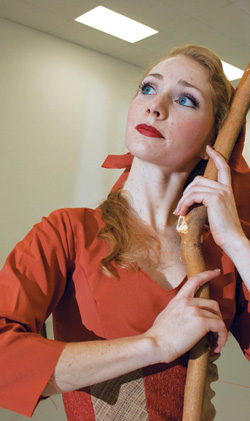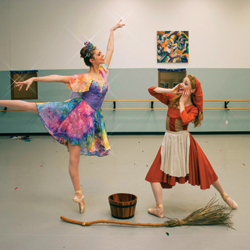Catch up with Peoria Ballet as it prepares for the spring performance of Cinderella.
For nearly 50 years, Peoria Ballet has staged a wide array of productions, from its classic performance of The Nutcracker every December to original works like The Changeless Mover, which premiered last fall. Founded by Jack Slater and Shirley Pizer in 1965, the organization has grown over the years—most notably with its expansion and move to its current location in 2008—all the while creating a welcoming environment for dancers ages three to 93.
More than 200 students are currently enrolled at the Peoria Ballet Academy—and many of them are busy preparing for the spring production of Cinderella, featuring music by the Russian composer Sergei Prokofiev and choreography by Peoria Ballet’s own artistic director, Servy Gallardo. A Venezuelan native who took up dance at the age of 15, Gallardo has been a principal dancer for a range of companies, including the National Ballet of Venezuela, Cleveland San Jose Ballet, Sacramento Ballet, North Carolina Dance Theatre and Chautauqua Ballet. On stage, he’s portrayed beloved characters from Romeo to Puck (of A Midsummer Night’s Dream), and more recently, has devoted his time to choreographing productions and creating new works to help usher classical ballet into the modern era.
Trends and Tradition
As dance continues to evolve, it now seems that being a great ballerina is only part of the package. In order to push their bodies to perform increasingly difficult choreography, today’s dancers must be well-versed in an array of genres and techniques. While the Peoria academy is focused on ballet, its instructors also teach jazz, tap and lyrical—a combination of ballet and jazz—all of which help build stamina and form and are key to becoming a well-rounded dancer.
Another trend in the dance world is the shift away from production-style dance, with its focus on large ballets requiring months of preparation, toward competitive dance, which involves learning new pieces and tumbling tricks to perform at competitions. Competitive dance also typically incorporates modern styles like hip hop into the curriculum—think Lifetime’s reality TV show, Dance Moms, for example.
Peoria Ballet, however, remains firmly in the production-based camp, says Academy Director Tamra Challacombe. “We’ve always had high-quality training, and we are the biggest and longest-standing in the area,” she notes. “Because we are ballet- and production-focused rather than competition-focused, if you’re looking for your child to do productions rather than just compete, this is the best venue.” With a variety of performances throughout the year, there are plenty of opportunities for students. “Instead of tricks,” adds Challacombe, “we carry on the tradition of technique.”

Envisioning the Dream
This focus on endurance and technique is sure to pay off with the company’s spring production. When it came to selecting a ballet to perform, Gallardo did not have to look far. Having staged Cinderella in 2007 with great success, Peoria Ballet has regularly rented out its sets and costumes ever since. For Gallardo, it seemed like the right time to put his own spin on the classic fairy tale. “It is such a beloved story,” he says, “among audience members of all ages.”
After deciding on Cinderella last fall, the ballet began its lengthy planning process, including fundraising, enlisting volunteers and casting the production. The costumes—from the Fairy Godmother’s vibrant outfit to Cinderella’s wedding dress—were all made by volunteers, and while many will be reused from the 2007 production, they are ready to create new costumes as needed to keep with the artistic director’s vision.
Gallardo’s years of dance experience are key to visualizing how the dancers will appear and move about onstage. His creative process is one of instinct and intuition; as he hears the music, his mind begins projecting conceptual images, which will become the choreography. “I just have to listen to the music and use my imagination to make the story and characters come to life,” the enigmatic director says.
Playing the coveted role of Cinderella is Allexe Slevin, who has been with Peoria Ballet for 14 years. “I’ve been watching videos and analyzing… her personality,” Slevin says, adding that becoming Cinderella is “a dream come true.” On top of teaching classes and rehearsing for her dream role, she also prepares using Pilates and cross-training. “There’s a lot that goes into dancing,” she says, echoing the words of Challacombe. “It’s not just the stuff you do in the studio; it’s stuff you need to do at home—exercises to become stronger. I’ve been working for that my entire life.”
The performance itself is sure to be memorable. “The ballet version of Cinderella is quite different from the Disney movie,” Slevin notes. Prokofiev composed the music right after he finished Romeo & Juliet, she says, so it is darker and more intense, while still appealing to a wide age range. “Servy is going to stick true to the principles of Cinderella, with the basic story line between the step-sisters and Cinderella,” Slevin says. “He also wants to make it more kid-oriented. He wants to involve a lot of the younger [students] in the show.” The process of learning the dances, staging the sets and perfecting technique is a long one, but Slevin says it’s all worth it once you get on stage.

What’s Ahead
While rehearsals for Cinderella are well underway, the company is also searching for a new executive director, as well as preparing for its spring recital and summer intensive. On May 29th, the spring recital will conclude the academy’s two-semester year, giving every student a “chance to shine in a specially choreographed piece,” Challacombe says. Meanwhile, the summer intensive will immerse dancers in classes for five intense weeks, culminating with a performance on July 19th.
As for the spring production of Cinderella, the costumes are ready and the stage is set; all that’s left is the interpretation of Gallardo’s vision. “The dancers don’t know what he’s going to do until he goes into the studio,” Slevin explains. “He doesn’t plan anything… He just goes into the studio, turns on music, and it just comes out. It’s amazing to [watch] the way he does things and how quickly his brain works—it’s unreal. We’ll just have to see what happens.” a&s


